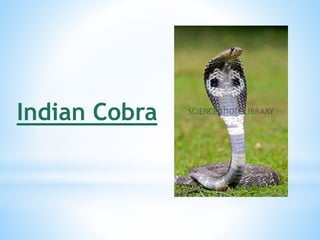
Indian Cobra
- 1. Indian Cobra
- 2. CONTENTS INTRODUCTION CLASSIFICATION MORPHOLOGY DISTRIBUTION AND HABITAT FEEDING AND BEHAVIOUR COBRA VENOM REPRODUCTION ECONOMIC IMPORTANCE CONSERVATION STATUS AND EFFORTS
- 3. INTRODUCTION • The Indian cobra is highly venomous snake with medium size and heavy body. • It is also known as the spectacled cobra, Asian cobra. It is quick and agile. • Indian cobra is diurnal and mostly active in evening and early morning. • The Indian cobra is a slender snake, usually weighing 6 to 10 kilograms, with the heaviest cobra weighing 12.6 kilos. • Their adults have length in meters ranging from 3 to 5 feet
- 5. CLASSIFICATION • The scientific name of Indian cobra is Naja naja. • Naja naja was first described by Swedish physician, zoologist, and botanist Carl Linnaeus in 1758. • Naja is a sanskrit word naga meaning "cobra". In Pakistan, Indian cobra is called by names like sheesh nag and kala nag.
- 6. CLASSI… Kingdom: Animalia Phylum: Chordata Class: Reptilia Order: Squamata Suborder: Serpentes Family: Elapidae Genus: Naja Species: Naja naja
- 7. MORPHOLOGY • It is a smooth-scaled snake with black eyes, a wide neck and head. • Cobras poisonous snake with hollow fangs (long pointed tooth) fixed at the front of the mouth. They inject venom through their fangs.
- 8. MORPH…. • The Indian Cobra's most known characteristic features are the wide black band on the underside of the neck • Cobras have round pupils and smooth scales, have varying colours and patterns. • The hood is another important feature. Hooding occurs when the snake spreads out its neck ribs forming a flattened structure near the head.
- 10. DISTRIBUTION AND HABBTAT • The Indian cobra is native to the Indian subcontinent and can be found throughout India, Pakistan, Sri Lanka, Bangladesh, and southern Nepal. • It is found in eastern Pakistan and thar and cholistan desert
- 12. DISTRI… • It can be found in dense or open forests, plains, agricultural lands (rice paddy fields, wheat crops), rocky terrain, wetlands, and it can even be found in heavily populated urban areas. • The cobra usually hides in holes in embarkments, termite mound, tree hollows rock piles, caves, cracks and small mammal dens. The Indian cobra is often found in the vicinity of water.
- 13. FEEDING AND BEHAVIOUR • Indian cobra feeds on rodents, lizards, and frogs. It feeds on small mammals as well. • It bites then waits while its venom damages the nervous system of the prey, paralyzing and often killing it and then swallows its whole prey. • When threatened, the Indian Cobra will assume its characteristic posture. • It will raise the front one-third of its body and elongate its long, flexible neck ribs and loose skin to form its distinctive hood
- 15. COBRA VENOM • The Indian cobra is one of the big four snakes of South Asia which are responsible for the majority of human deaths by snakebite in Asia. • The venom is highly neurotoxic and contain powerful post-synaptic neurotoxins, cardiotoxins and other components. • The venom paralysed the muscles and in severe bites it can lead to respiratory failure or cardiac arrest and ultimately to death. The venom acts faster and symptoms appear in 15 minutes. • Anti-venom is available. Polyvalent anti-venom serum is used to treat it.
- 16. REPRODUCTION • Indian cobras are oviparous and lay their eggs between the months of April and July. • The eggs are usually 12 to 20 and laid in a hollow tree, or in the earth. • The female will guard them throughout the incubation period. The young snakes will then hatch after approximately 50 days. • The life span of Indian cobra is 23.9 years on average but maximum lifespan is 32.3 years.
- 18. ECONOMIC IMPORTANCE The Indian cobras are important as they keep balance in nature. Positive importance: The Indian Cobra eats rats and mice that carry disease. Also, cobra venom is a potential source of medicines, including anti-cancer drugs and pain-killers. Negative importance: This species is highly venomous and its bite can be lethal and many people die each year from N.naja bites.
- 19. CONSERVATION STATUS Status: The Indian Cobra was not an endangered species, it has recently been hunted for its distinctive hood markings in the production of handbags. Its status is now in endangered species listed by CITES.
- 20. CONSER… Threats: Deforestation, reclamation and overgrazing are the main threats to the cobras in Pakistan. Every year thousands of cobras are killed in Pakistan for their skins. Snake charmers capture cobras to stage fights with mongoose in rural and urban areas, also used in medicines. Efforts: CITES has included the Indian cobra on its roster of animals that need a permit for export, and also sets quotas on how many of the cobras can be exported yearly